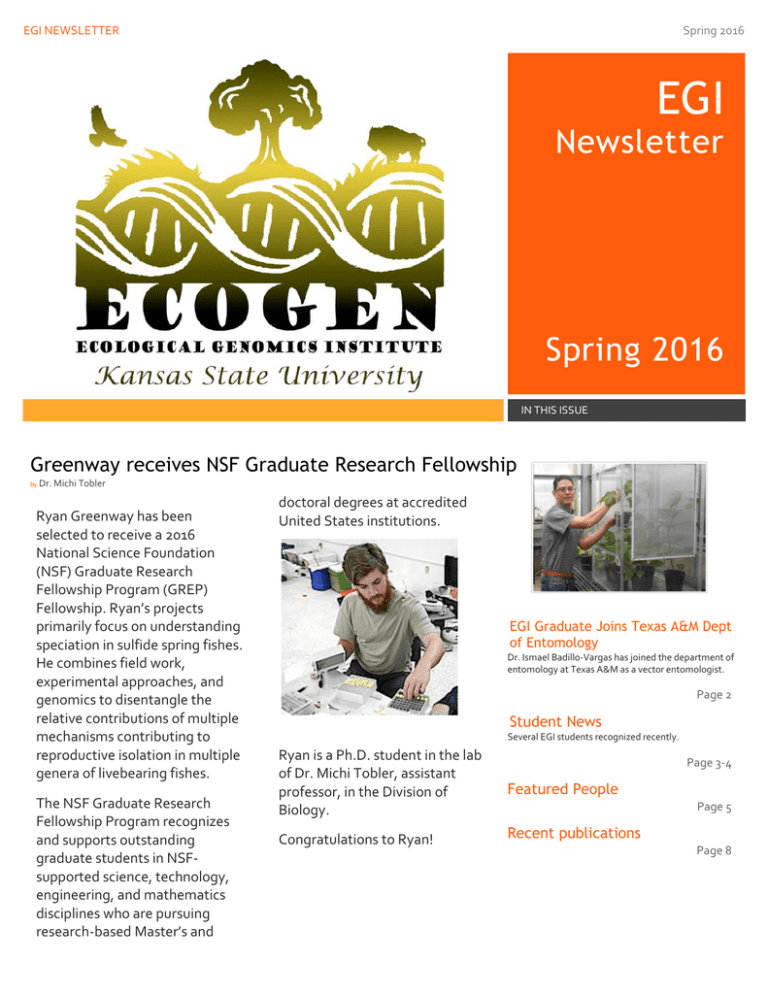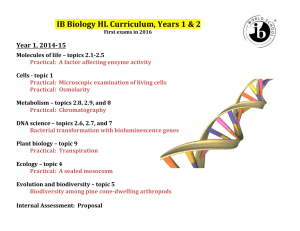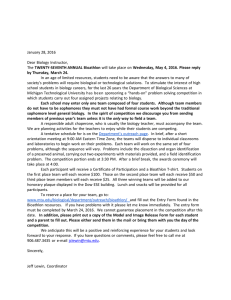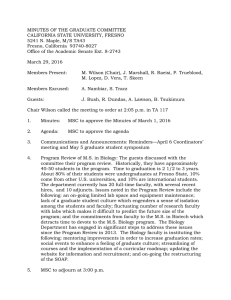EGI Newsletter Spring 2016 Greenway receives NSF Graduate Research Fellowship
advertisement

EGI NEWSLETTER Spring 2016 EGI Newsletter Spring 2016 IN THIS ISSUE Greenway receives NSF Graduate Research Fellowship by Dr. Michi Tobler Ryan Greenway has been selected to receive a 2016 National Science Foundation (NSF) Graduate Research Fellowship Program (GREP) Fellowship. Ryan’s projects primarily focus on understanding speciation in sulfide spring fishes. He combines field work, experimental approaches, and genomics to disentangle the relative contributions of multiple mechanisms contributing to reproductive isolation in multiple genera of livebearing fishes. The NSF Graduate Research Fellowship Program recognizes and supports outstanding graduate students in NSFsupported science, technology, engineering, and mathematics disciplines who are pursuing research-based Master’s and doctoral degrees at accredited United States institutions. EGI Graduate Joins Texas A&M Dept of Entomology Dr. Ismael Badillo-Vargas has joined the department of entomology at Texas A&M as a vector entomologist. Page 2 Student News Several EGI students recognized recently. Ryan is a Ph.D. student in the lab of Dr. Michi Tobler, assistant professor, in the Division of Biology. Congratulations to Ryan! Page 3-4 Featured People Page 5 Recent publications Page 8 EGI NEWSLETTER | Spring 2016 2 14th Annual Symposium Scheduled The 14th Annual Ecological Genomics Institute symposium is scheduled for October 28-30, 2016, in Kansas City, Missouri, at the Marriott Country Club Plaza. More details available soon!! EGI Graduate Joins Texas A&M Department of Entomology Taken from Texas A&M Department of Entomology The Department of Entomology, Texas A&M welcomes Dr. Ismael Badillo-Vargas to its faculty roster. Ismael started on February 1 as the newest vector entomologist for the Texas A&M AgriLife Research Center in Weslaco. Ismael was born and raised in Puerto Rico and graduated from the University of Puerto Ric0 – Mayagüez with a Bachelor of Science in Crop Production, a Master of Science in Plant Pathology from the University of Wisconsin-Madison and his Ph.D. in Plant Pathology from Kansas State University, where he was a member of the Dr. Anna Whitfield, associate professor of Plant Pathology, lab. Before coming to Texas A&M, Ismael was a Postdoctoral Research Associate at Kansas State and then moved to the University of Florida where he was a postdoctoral research associate within a partnership with the university and the US Department of Agriculture’s Horticultural Research in Fort Pierce. At Florida, he continued studying the interactions between insects and the plant pathogens they transmit and characterizing emerging and re-emerging plant viruses in vegetables. The overarching goal of his program will be to seek to combine basic and applied research to understand the fundamental aspects that underlie the intrinsic plant-insect vector-pathogen interactions. He wants to be able to develop novel strategies, couples with more conventional approaches, can become the basis of sound integrated management programs to support growers. These programs can not only support the growers, but can also strengthen the economy and promote a healthier environment, he said. Congratulations to Ismael! Whitfield Receives Recognition Anna Whitfield, EGI steering committee member, was recently promoted to full professor in the department of plant pathology. Additionally, she was named the 2016 KSU Sigma Xi Chapter Outstanding Scientist. This award recognizes KSU Sigma Xi members who have demonstrated outstanding accomplishments in scientific research. Congratulations to Dr. Whitfield! EGI NEWSLETTER | Spring 2016 Student News Galliart and Sharpe awarded Sigma Xi Research Grants Matthew Galliart is the recipient of a National Sigma Xi Grant-in-Aid of Research grant. Sigma Xi awarded Galliart a $1,000 grant in support of his research proposal, “Experimental natural selection of big bluestem ecotypes across the Great Plains: A novel test for the strength of local adaptation.” The Sigma Xi Grant-in-Aid of Research program has a highly competitive application process and only approximately 15 percent of all applicants receive any level of funding. Sigma Xi is the national scientific research society. Samantha Sharpe received a KSU Sigma Xi research grant. Sharpe was awarded a $400 award in support of her proposal, “Andropogon virginicus tolerance of heavy metals in abandoned mine sites: an investigation of local adaptation and rapid evolution.” Galliart and Sharpe are Ph.D. students in the Division of Biology working in ecological genomics in the lab of Loretta Johnson. 4 EGI undergraduates awarded Johnson Cancer Research Center awards Four EGI undergraduates were recently selected by the Johnson Cancer Research Center at Kansas State University to participate in its research mentoring and award program. The center’s undergraduate Cancer Research Award program promotes early participation in laboratory research, encouraging students to consider careers in cancer research and medicine while they’re still deciding what academic and professional paths to take. The award program provides $1,000 awards to up to 50 students a year, and $1,000 per student for research expenses. The EGI undergraduates selected are: Ella Popova, senior in biology and member of the Dr. Michael Herman lab Samantha Schluter-Pascua, junior in microbiology and member of the Dr. Brad Olson lab Jaden Anderson, senior in biology and member of the Dr. Brad Olson lab Vaitish Velazhahan, sophomore in biology and member of the Dr. Kathrin Schrick lab Congratulations to these undergraduates! 3 EGI NEWSLETTER | Spring 2016 4 Student News Passow receives postdoc fellowship at University of Minnesota Courtney Passow received a Grand Challenges in Biology Postdoctoral Program Fellowship of the University of Minnesota. She will start her postdoctoral fellowship this fall upon graduating from the Biology Ph.D. program. She will primarily be working with blind Mexican cavefish (Astyanax mexicanus), investigating how organisms adapt to nutrient and light-poor cave environments. In particular, Courtney will be utilizing new technological and theoretical tools to identify changes in gene co-expression networks between cave and surface populations and test whether divergent co-expressed nodes are also under direct selection. Courtney will conduct this work in collaboration with Dr. Suzanne McGaugh (Department of Ecology, Evolution and Behavior, University of Minnesota) and Dr. Peter Tiffin (Department of Plant Biology, University of Minnesota). The Grand Challenges in Biology Postdoctoral Program fosters collaboration between postdoctoral researchers and faculty interested in multidisciplinary research that address societally relevant problem. Postdoctoral researchers develop a 2-year research project under the guidance of faculty advisors at the College of Biological Sciences at the University of Minnesota. The fellowship includes a stipend of $46,000 a year plus benefits of $5,000 per year for research supplies and research related travel. The fellowship is potentially renewable for a third year. Alsdurf and Galliart are K-State GRAD Forum Winners Jacob Alsdurf and Matthew Galliart were recent oral presentation winners at the K-State Graduate Research, Arts, and Discovery (GRAD) forum. Jacob placed first in the agricultural sciences category and will be given a $500 scholarship. Matthew took second place in the agricultural sciences category, receiving a $250 scholarship. The scholarships will awarded at the 2nd Annual Kansas State University Graduate Student Awards and Recognition Reception on Tuesday, April 5. Both are Ph.D. students working in the lab of Dr. Loretta Johnson, professor in the Division of Biology. Congratulations to Jake and Matt! Sharpe and Galliart recipients of KAS research grants Samantha Sharpe and Matthew Galliart are both recent recipients of Kansas Academy of Science graduate research grants. The title of Samantha’s project is “Rapid adaptation in a contaminated environment: Evolutionary adaptive response of old field grass Andropogon virginicus to heavy metals in abandoned Lead and Zinc mines.” The grants supplies a $1,500 award for research. Matt’s project is entitled “Experimental natural selection of big bluestem ecotypes across the Great Plains: A novel test for the strength of local adaptation.” Matt’s grant will provide $1,000 for research. Both are graduate students working in the lab of Dr. Loretta Johnson, professor in the Division of Biology. EGI NEWSLETTER | Spring 2016 Featured People Leah Radeke Graduate Teaching Assistant Leah Radeke was raised in Green Bay, Wisconsin and received her bachelor’s degree in biology from the University of Wisconsin-Eau Claire. One of her undergraduate research projects investigated gene expression in non-model grass species in response to elevated carbon dioxide and elevated nitrogen. Another project looked at behavioral and olfactory bulb activity in minnows in response to Alarm Substance. While earning her undergraduate degree, Leah served an internship at the Eau Claire City-County Health Department. During the internship, she was the project manager of a vector-bourne disease surveillance project in which ticks in Eau Claire County were tested for Ehrlichia and Borrelia. Leah is working in the lab of Dr. Michael Herman studying the genetic mechanisms underlying the innate immune response in Caenhorabditis elegans to a virulent strain of Stenotrophomonas maltophilia. Marcus Olatoye PhD Student Marcus was raised in the southwestern part of Nigeria and after an internship during his third-year in college, he became passionate about plant breeding. The quest to receive qualitative research and academic training first took him to Universitat Hohenheim, Stuttgart, where Marcus first worked on using molecular genomic tools to identify genomic regions underlying adaptive traits to low-phosphorus conditions in sorghum. This aroused his interest in genomic applications to understand agronomically important adaptive traits in breeding. Currently, Marcus is working on his PhD and is employing quantitative and population genomic tools to understand the genetic basis of agroclimatic traits in sorghum. His advisor is Dr. Geoff Morris, assistant professor in the department of agronomy. Jacques Faye PhD Student Jacques received his master’s degree from the University Cheikh Anta Diop of Dakar in Senegal. He started his PhD training this semester and it focuses on plant genetics and genomics in Dr. Geoffrey Morris’ lab at the Department of Agronomy. Jacques is interested in determining the genetic structure of sorghum germplasm from West Africa and the identification of genetic variations associated with agronomical traits related to yield components and stability under water stress. Their program is using genotyping-by-sequencing and genome-wide association studies to understand the genetic mechanisms of sorghum resistance to post-flowering drought and develop genomic material to improve sorghum resistance to drought stress. Jacques is also interested in learning bioinformatics tools accompanying the field of genetics and genomics for crop improvement and adaptation. Fanna Maina PhD Student Fanna is a native of Niger Republic, a West African country. She grew up with her siblings and cousins in Zinder where they hung out in its rocky area. She likes cooking and playing Scrabble and Monopoly. She holds an engineering degree in biotechnology from the University of Blida in Algeria. She continued her training at the University of Maradi in Niger where she received her master’s degree in biodiversity and environmental management with honors. She gained knowledge in various fields of agricultural sciences. Her professional experiences have allowed her to acquire new knowledge in molecular biology, biodiversity and agronomy in her country. She is interested in crop improvement and using genomics to help breeding programs. Currently, she is a PhD student with Dr. Geoffrey Morris in the Department of Agronomy. Her research focuses on understanding the genetic variability of sorghum (one of the most cultivated crops in Niger), and developing new tools that will master the challenges of agricultural production. 5 EGI NEWSLETTER | Spring 2016 Genetics help fish thrive in toxic environments, collaborative study finds Taken from K-State Today They live in caves and springs throughout Mexico and thrive in water so toxic that most forms of life die within minutes. Meet the Atlantic molly – and extremophile fish that lives in toxic water full of hydrogen sulfide from natural oil deposits and volcanic activity environments. A 10-year collaborative project led by biologists from Kansas State University and Washington State University has discovered how the fish can survive. The answer: It’s all in the genes. The research appears in Molecular Biology and Evolution. “Learning how these extremophiles function tells us something very fundamental about life itself,” said Michael Tobler, Kansas State University assistant professor of biology involved in the project. “We are able to learn about the boundaries where life can exist, which tells us something basic about how cells and organisms work.” The tiny Atlantic molly can live in small puddles of toxic and nontoxic water. Using genomic tools, the researchers compared gene expression of the mollies living in toxic hydrogen sulfide environments with those mollies living in nontoxic environments just a few yards away. They found that the fish have a two-pronged approach to survival: They become inert to the toxins that enter the body and they are able to detoxify hydrogen sulfide more efficiently. Hydrogen sulfide shuts down energy production in cells by interfering with specific proteins. The fish combat this challenge by using anaerobic metabolism, which is an alternative – although much less efficient – way to produce energy and does not involve oxygen. The scientists found that about 170 of the fish’s 35,000 or so genes were turned on, or upregulated, to detoxify and remove the hydrogen sulfide. The poison invades the fishes’ bodies, but their changed proteins help the fish break down the hydrogen sulfide into nontoxic forms and excrete it. “It’s not that they’re keeping the hydrogen sulfide out,” said Joanna Kelley, a genome scientist at Washington State University and collaborator on the project. “It’s not that they are necessarily turning on some other unrelated genes. It’s really that the genes that have been previously implicated in hydrogen sulfide detoxification are turned on or turned up. That’s really the exciting part.” As part of the collaborative project, Tobler studied the toxic environments and fish physiology while processing sulfur. Because hydrogen sulfide is toxic to nearly all living creatures, Tobler and his collaborators had to wear protective gear and respirators to study the fish in toxic habitats. “Comparing the fish in sulfidic and nonsulfidic environments helps us learn about the physiological processes that are involved in processing these molecules,” Tobler said. “We can use this knowledge for developing biomedical applications.” While hydrogen sulfide is toxic in high concentrations, it is fundamental for life at low concentrations. When human cells do not produce enough sulfide, it can lead to health problems, such as cardiovascular disease, inflammation and brain function issues. Biomedical research is developing drugs that modulate hydrogen sulfide production in humans to prevent health issues, Tobler said, and the Atlantic molly provides a good model. The research is also important for understanding the long-term effects of human-caused change and pollution, Tobler said, because the Atlantic molly appears in naturally occurring toxic water. “In these habitats, the natural pollutants give us a glimpse into the future and help us think about what happens in ecosystems that suffer from human-induced changes or pollution,” Tobler said. “We can learn how an ecosystem changes when pollutants are added and how organisms cope with that.” Tobler and Kelley collaborated with researchers at Mexico’s Universidad Juárez Autónoma de Tabasco, Stanford University and the Carnegie Institute for Science. The project received funding from the National Science Foundation and the Army Research Office. The Division of Biology is in Kansas State University’s College of Arts and Sciences. 6 EGI NEWSLETTER | Spring 2016 7 Galliart and Olatoye Winners at Statewide Research Summit at State Capitol Taken from K-State Today Two EGI members, Matthew Galliart and Marcus Olatoye, received statewide recognition for their Kansas-related research at the 13th Capitol Graduate Research Summit, February 2, at the State Capitol in Topeka. Galliart, master's student in biology, was one of two Kansas State University winners and received a $500 scholarship from the Graduate School. Olatoye, doctoral student in agronomy, was the Kansas State University winner of the $500 BioKansas scholarship, which is supported by BioKansas. “The K-State students’ presentations were professional and were a positive reflection on the quality of our graduate programs and the research being conducted,” said Carol Shanklin, dean of the Graduate School. “Judges for the event commented on how difficult it was for them to select from among all the excellent research and presentations. They noted that the students were well prepared and their responses reflected the depth of their knowledge of the research and how the results can benefit Kansas.” The BioKansas award not only recognizes the top researchers, but also those projects that have the best potential for commercialization and for impacting the state of Kansas, said Dennis Ridenour, president and CEO of BioKansas. “Marcus Olatoye’s work stuck out to us, as he was extremely well spoken and it was readily apparent that he understood both the work he was doing and the import of that work,” Ridenour said. “It also helped that his research has tremendous potential to impact agriculture both here in Kansas and abroad in developing nations.” Galliart’s poster was “Adaptive ecotypic variation and genetic divergence of a widespread grass Andropogon gerardii across a great plains’ climate gradient.” His adviser is Loretta Johnson, professor of biology. “Kansas has the largest expanses of native prairie remaining and is the third largest cattle-producing state in the United State,” Galliart said. “My research seeks to characterize natural trait variation and the underlying genomics of big bluestem across a natural precipitation gradient in the Great Plains.” Olatoye’s poster was “Genomic dissection of leaf and panicle architecture traits in sorghum using nested association mapping.” His faculty mentor is Geoffrey Morris, assistant professor of agronomy. Olatoye’s research focuses on understanding the genetic basis of adaptive agro-ecological traits in sorghum. And how these can be used to develop molecular genetic tools to breed for better adapted and yielding sorghum varieties needed by farmers in the state. “Having won the BioKansas award is encouraging to me and my lab members because society appreciates what we do and encourages us to bring more to the table in addressing pressing challenges,” Olatoye said. “One member of the Kansas Sorghum Commission told me that he is glad that we have new kids who are interested in sorghum research.” EGI NEWSLETTER | Spring 2016 8 Recent Publications Adkins J, Jastrow JD, Morris GP, Six J, de Graaff MA. 2016. Effects of switchgrass cultivars and intraspecific differences in root structure on soil carbon inputs and accumulation. Geoderma. 262:147-154. Barandoc-Alviar, K., Ramirez, G.M., Rotenberg, D. and Whitfield, A.E. Analysis of acquisition and titer of Maize mosaic rhabdovirus in its vector, Peregrinus maidis (Hemiptera: Delphacidae). (Submitted). Boyles RE, Cooper EC, Myers MT, Brenton Z, Rauh BL, Morris GP, Kresovich S. 2016. Genome-wide association studies of grain yield components in diverse sorghum germplasm. The Plant Genome. 10.3835/plantgenome2015.09.0091. Brown, S.P., Ungerer, M.C., and Jumpponen, A. 2016. A community of clones: snow algae are diverse communities of spatially structured clones. International Journal of Plant Sciences. In Press. Culumber, Z. W., G. W. Hopper, N. Barts, C. N. Passow, S. Morgan, A. Brown, L. Arias-Rodriguez & M. Tobler (accepted): Habitat use of two extremophile, highly endemic, and critically endangered fish species (Gambusia eurystoma and Poecilia sulphuraria; Poeciliidae). Aquatic Conservation Marine and Freshwater Ecosystems. Culumber, Z.W. & M. Tobler. 2016. Ecological divergence and conservatism: spatiotemporal patterns of niche evolution in a genus of livebearing fishes (Poeciliidae: Xiphophorus). BMC Evolutionary Biology 16: 44. Culumber, Z.W. & M. Tobler. 2016. Spatiotemporal environmental heterogeneity and the maintenance of tailspot polymorphism in the variable platyfish (Xiphophorus variatus). Evolution 70 (2): 408-419. Fitzgerald, D.B., M. Tobler & K.O. Winemiller. (in press): From richer to poorer: successful invasion by freshwater fishes depends on species richness of donor and recipient basins. Global Change Biology. Hopper, G., R.L. Moorhouse & M. Tobler. (in press): Body shape variation in two species of darters (Etheostoma, Percidae) and its relation to the environment. Ecology of Freshwater Fish. Hopper, G. & M. Tobler. 2016. Patterns of tropic resource use and individual specialization in two species of darters (Etheostoma, Percidae). Evolutionary Ecology Research 17 (1): 53-73. Kelley, J.L., L. Arias-Rodriguez, D. Patacsil Martin, M. C. Yee, C. Bustamante, & M. Tobler (accepted): Mechanisms underlying adaptation to life in hydrogen sulfide rich environments. Molecular Biology and Evolution. Montero-Astua, M., Ullman, D.E. and Whitfield, A.E. Dynamics of TSWV infection and spread in its insect vector, Frankliniella occidentalis, with an emphasis on the principal salivary glands. (Manuscript written and in review by colleagues). Raithel, S., Johnson, L., Galliart, M., Brown, S., Shelton, J., Herndon, N., Bello, N. 2016. Inferential considerations for low-count RNA-seq transcripts: a case study on the dominant prairie grass Andropogon gerardii. BMC Genomics. Accepted for publication. Rotenberg, D., Bockus, W.W., Whitfield, A.E., Hervey, K., Baker, K., Ou, Z., Laney, A., DeWolf, E.D., and Appel, J.A. Occurrence of Barley yellow dwarf virus and Wheat streak mosaic virus and their contributions to yield losses in winter wheat fields in Kansas. (Submitted). Tetreault, HM, Kawakami, T., Levy, C., Ungerer, MC. 2016. Low temperature tolerance in the perennial sunflower Helianthus maximiliani. American Midland Naturalist 175: 91-102. Tobler, M., D.M. Alba, L. Arias-Rodriguez & P.D. Jeyasingh. 2016. Using replicated evolution in extremophile fish to understand diversification in elemental composition and nutrient excretion. Freshwater Biology 61 (1): 158-171. Upadhyaya HD, Wang YH, Dintyala SV, Dwivedi SL, Prasad PVV, Burrell AM, Klein R, Morris GP, Klein PE. 2016. Association mapping of germinability and seedling vigor in sorghum under controlled low temperature conditions. Genome. White, CV, Darby, BJ, Breeden, RJ, Herman MA 2016 A Stenotrophomonas maltophilia strain evades a major Caenorhabditis elegans defense pathway. Infect. Immun. 84: 524-536. Zeglin, L.H., B. Wang, F. Rainey, C. Waythomas, and S.L. Talbot. 2016. Organic matter quantity and source affects microbial community structure and function following volcanic eruption on Kasatochi Island, Alaska. Environmental Microbiology 18(1): 146-158. Zhu, K.Y., Merzendorfer, H., Zhang, W., Zhang, J. & Muthukrishnan, S. Biosynthesis, turnover and function of chitin in insects. Annual Review Entomology (in press for 2016).




